Native
Amorbia cuneanum (Walsingham) (Tortricidae: Tortricinae: Sparganothini)
Common names: western avocado leafroller
Synonyms: adumbrana (Amorbia), essigana (Amorbia), synneurana (Amorbia)
Note: preliminary studies on the pheremone composition and COI sequence data suggests that A. cuneanum species may be two distinct species (Powell & Brown 2012).
FWLFWL:
forewing length; the distance from the base of the forewing to the apex, including fringe : 10.0-14.5 mm (males); 13.5-17.5 mm (females)
: 10.0-14.5 mm (males); 13.5-17.5 mm (females)
Male forewing color varies from pale tan to rust to dark gray brown. Many individuals have a dark costal spotcostal spot:
a patch of contrasting scales on the costa, usually a remnant of the postmedian or preterminal fascia 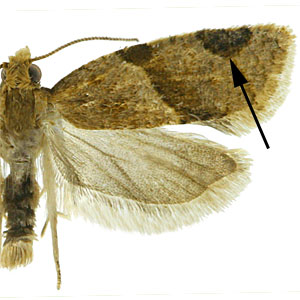 that is a remnant of the median fasciafascia:
that is a remnant of the median fasciafascia:
a dark transverse band on the forewing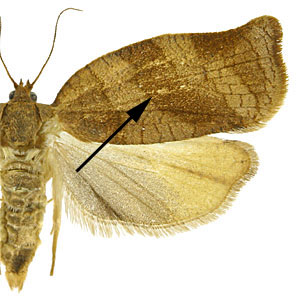 or more well-defined transverse markings. Females have a more uniform rust to tan forewing with obscured marking. Males lack a forewing costal foldforewing costal fold:
or more well-defined transverse markings. Females have a more uniform rust to tan forewing with obscured marking. Males lack a forewing costal foldforewing costal fold:
a flap or fold at the base of the forewing that contains specialized sex scales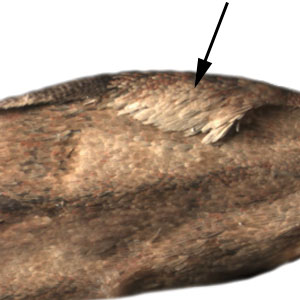 . A dorsaldorsal:
. A dorsaldorsal:
upper, to the top, on the back 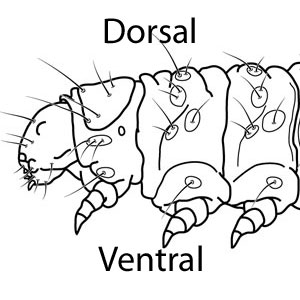 pit is present on the second abdominal segment and ocelliocelli:
pit is present on the second abdominal segment and ocelliocelli:
adult head - a simple insect "eye" located dorsal to the compound eye; plural of ocellus 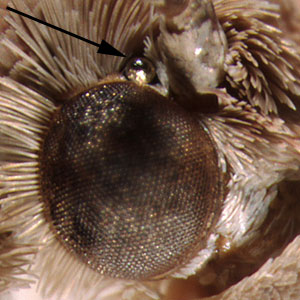 are absent.
are absent.
Male genitalia are characterized by a long, thin uncusuncus:
a sclerotized process which is fused to the posterodorsal margin of tergum IX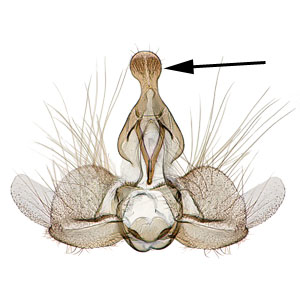 ; large, setosesetose:
; large, setosesetose:
covered with setae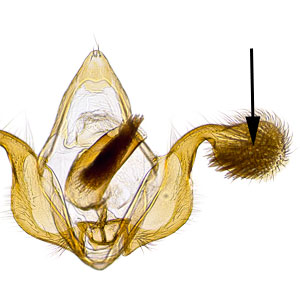 sociisocii:
sociisocii:
a pair of lightly sclerotized setose lobes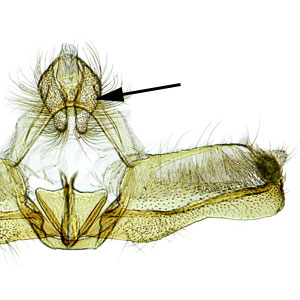 ; and large, membranous valvaevalva:
; and large, membranous valvaevalva:
an appendage flanking the intromittent organ that is used to clasp the female during copulation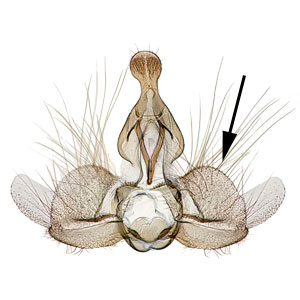 . Female genitalia are characterized by a sterigmasterigma:
. Female genitalia are characterized by a sterigmasterigma:
the sclerotized region surrounding the female ostium bursae 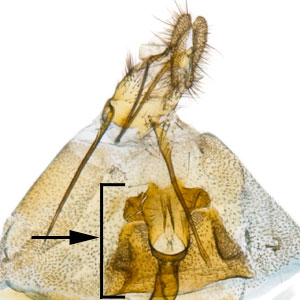 with well-developed laterallateral:
with well-developed laterallateral:
to the side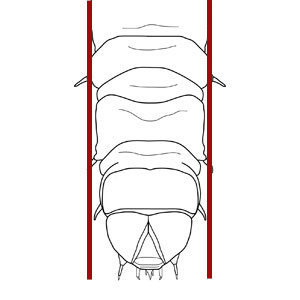 lobes and a band-like signumsignum:
lobes and a band-like signumsignum:
a sclerotized projection or patch on the interior of the corpus bursae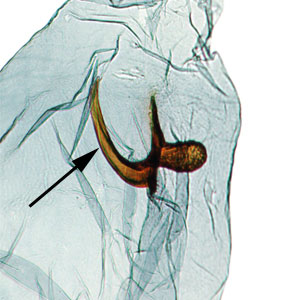 on the wall of the corpus bursaecorpus bursae:
on the wall of the corpus bursaecorpus bursae:
a dilated membranous sac at the anterior end of the bursa copulatrix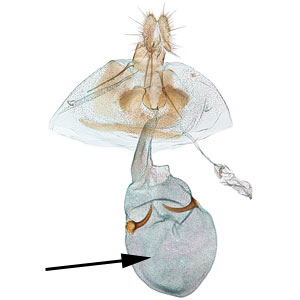 .
.
The following account is summarized from MacKay (1962a) and Powell & Brown (2012).
Mature larvae approximately 25mm in length; width of head 2.1-2.9 mm; head yellowish brown; prothoracic shieldprothoracic shield:
a sclerotized plate on the dorsal surface of the prothorax 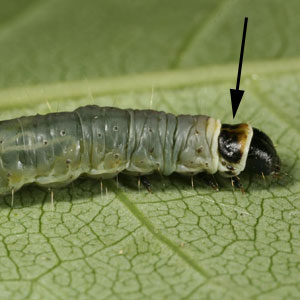 concolorous but with dark brown laterallateral:
concolorous but with dark brown laterallateral:
to the side bands; legs brown; body pale yellow or green; SV group on A1, 2, 7, 8, 9 numbering 3:3:3:2:2.
bands; legs brown; body pale yellow or green; SV group on A1, 2, 7, 8, 9 numbering 3:3:3:2:2.
For more information on Amorbia larvae, including a more detailed account of chaetotaxychaetotaxy:
the arrangement of setae (in reference to Lepidoptera larvae), often depicted on a "setal map"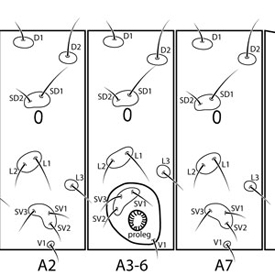 , please consult the fact sheet and keys on LepIntercept.
, please consult the fact sheet and keys on LepIntercept.
Few other North American tortricids are similar in size or appearance to Amorbia, and this is one of the few tortricid genera in which the adults lack ocelliocelli:
adult head - a simple insect "eye" located dorsal to the compound eye; plural of ocellus  . The three Amorbia species treated on this site can be separated by the combination of two characters: forewing color and number of median dorsaldorsal:
. The three Amorbia species treated on this site can be separated by the combination of two characters: forewing color and number of median dorsaldorsal:
upper, to the top, on the back  pits on the abdomen. Amorbia humerosana is gray, oftentimes with a brownish band on the inner margininner margin:
pits on the abdomen. Amorbia humerosana is gray, oftentimes with a brownish band on the inner margininner margin:
see dorsum 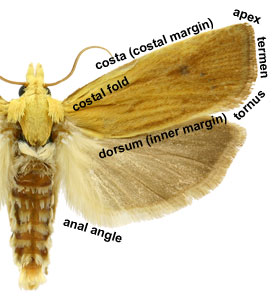 and has a single median dorsal pit on the second abdominal segment. Both A. emigratella and A. cuneanum are yellow-orange or yellow-brown, but A. cuneanum has a median dorsal pit on segment 2 whereas A. emigratella has median dorsal pits on segments 2-6.
and has a single median dorsal pit on the second abdominal segment. Both A. emigratella and A. cuneanum are yellow-orange or yellow-brown, but A. cuneanum has a median dorsal pit on segment 2 whereas A. emigratella has median dorsal pits on segments 2-6.
The lateral bands on the prothoracic shieldprothoracic shield:
a sclerotized plate on the dorsal surface of the prothorax  can be used to distinguish late instar Amorbia larvae from those of many other tortricids. Early instars lack the distinctive dark bands, and morphological identification of early instar larvae may be difficult or impossible.
can be used to distinguish late instar Amorbia larvae from those of many other tortricids. Early instars lack the distinctive dark bands, and morphological identification of early instar larvae may be difficult or impossible.
The following account is summarized from Phillips-Rodríguez & Powell (2007) and Powell & Brown (2012).
Amorbia cuneanum completes two generations per year in northern California, where adults are present in May through June and again in October. In southern California, A. cuneanum is multivoltine and adults have been recorded every month of the year.
Larvae feed on leaves, skeletonizing them in early instars and consuming the entire leaf in later instars. Larvae also web leaves to fruit and feed on the skin of fruit in a cluster, sometimes causing economic damage.
Amorbia cuneanum can be a significant pest of avocado in California. Its putative synonym, A. essigana Busck, was described as an avocado pest in southern California in 1929, and it is possible that avocado-feeding populations may represent this "pheromone race."
Amorbia cuneanum feeds on plants in several families although it is usually recognized as a pest of avocado.
| Host plant | Host plant family | Reference(s) | |||||||||
| Malosma laurina | Anacardiaceae | Phillips-Rodriguez & Powell 2007 | |||||||||
| Lonicera japonica | Caprifoliaceae | Phillips-Rodriguez & Powell 2007; USNM collectionUSNM collection: USNM collection. Based on identified reared specimens in the collection of the National Museum of Natural History, Washington, D.C. |
|||||||||
| Arbutus menziesii | Ericaceae | Prentice 1966Prentice 1966: Prentice, R. M. 1966. Vol. 4. Microlepidoptera. In : Forest Lepidoptera of Canada recorded by the Forest Insect Survey. Dept. For. Canada Publ. 1142: 543-840.; Powell 2006Powell 2006: Powell, J. A. 2006. Database of Lepidoptera rearing lots, 1960-2005. University of California Berkeley, CA. |
|||||||||
| Arctostaohylos glauca | Ericaceae | Phillips-Rodriguez & Powell 2007; LACM IndexLACM Index: LACM Index. Records from the card file at the Los Angeles County Museum of Natural History, Los Angeles, California; transcribed by Gaeden Robinson (BMNH). |
|||||||||
| Arctostaphylos insularis | Ericaceae | Powell 2006Powell 2006: Powell, J. A. 2006. Database of Lepidoptera rearing lots, 1960-2005. University of California Berkeley, CA.; Phillips-Rodriguez & Powell 2007 |
|||||||||
| Arctostaphylos patula | Ericaceae | Valenti & Zack 1995 | |||||||||
| Arctostaphylos sp. | Ericaceae | Meyrick MS 1938Meyrick MS 1938: Meyrick MS 1938. Unpublished manuscript by E. Meyrick at BMNH, data captured by Gaeden Robinson.; MacKay 1962aMacKay 1962a: MacKay, M. R. 1962a. Larvae of the North American Tortricinae (Lepidoptera: Tortricidae). Canadian Entomologist, Supplement 28: 1-182.; Powell 2006Powell 2006: Powell, J. A. 2006. Database of Lepidoptera rearing lots, 1960-2005. University of California Berkeley, CA. |
|||||||||
| Arctostaphylos viscida (ID uncertain) | Ericaceae | Powell 2006Powell 2006: Powell, J. A. 2006. Database of Lepidoptera rearing lots, 1960-2005. University of California Berkeley, CA. |
|||||||||
| Ribes sanguineum | Grossulariaceae | Powell 2006Powell 2006: Powell, J. A. 2006. Database of Lepidoptera rearing lots, 1960-2005. University of California Berkeley, CA. |
|||||||||
| Trichostema lanceolatum | Lamiaceae | Powell 2006Powell 2006: Powell, J. A. 2006. Database of Lepidoptera rearing lots, 1960-2005. University of California Berkeley, CA. |
|||||||||
| Cinnamomum camphora | Lauraceae | Powell 2006Powell 2006: Powell, J. A. 2006. Database of Lepidoptera rearing lots, 1960-2005. University of California Berkeley, CA. |
|||||||||
| Laurus nobilis | Lauraceae | MacKay 1962aMacKay 1962a: MacKay, M. R. 1962a. Larvae of the North American Tortricinae (Lepidoptera: Tortricidae). Canadian Entomologist, Supplement 28: 1-182. |
|||||||||
| Laurus sp. | Lauraceae | Phillips-Rodriguez & Powell 2007 | |||||||||
| Persea americana | Lauraceae | LACM IndexLACM Index: LACM Index. Records from the card file at the Los Angeles County Museum of Natural History, Los Angeles, California; transcribed by Gaeden Robinson (BMNH).; Busck 1929Busck 1929: Busck, A. 1929. A new avocado moth. Monthly Bulletin of the Department of Agriculture, State of California 18: 276-277.; Faber et al. 2001; Waite & Barrera 2002, Wysoki et al. 2002; Phillips-Rodriguez & Powell 2007 |
|||||||||
| Persea sp. | Lauraceae | LACM IndexLACM Index: LACM Index. Records from the card file at the Los Angeles County Museum of Natural History, Los Angeles, California; transcribed by Gaeden Robinson (BMNH). |
|||||||||
| Umbellularia californica | Lauraceae | LACM IndexLACM Index: LACM Index. Records from the card file at the Los Angeles County Museum of Natural History, Los Angeles, California; transcribed by Gaeden Robinson (BMNH).; Meyrick MS 1938Meyrick MS 1938: Meyrick MS 1938. Unpublished manuscript by E. Meyrick at BMNH, data captured by Gaeden Robinson.; Busck 1929Busck 1929: Busck, A. 1929. A new avocado moth. Monthly Bulletin of the Department of Agriculture, State of California 18: 276-277.; Phillips-Rodriguez & Powell 2007 |
|||||||||
| Abies concolor | Pinaceae | Powell & De Benedictis 1996; Phillips-Rodriguez & Powell 2007 | |||||||||
| Pseudotsuga menziesii | Pinaceae | Powell & De Benedictis 1996; Powell 2006Powell 2006: Powell, J. A. 2006. Database of Lepidoptera rearing lots, 1960-2005. University of California Berkeley, CA. |
|||||||||
| Ceanothus arboreus | Rhamnaceae | Powell 2006Powell 2006: Powell, J. A. 2006. Database of Lepidoptera rearing lots, 1960-2005. University of California Berkeley, CA.; Phillips-Rodriguez & Powell 2007 |
|||||||||
| Ceanothus luecodermis | Rhamnaceae | Powell 2006Powell 2006: Powell, J. A. 2006. Database of Lepidoptera rearing lots, 1960-2005. University of California Berkeley, CA. |
|||||||||
| Ceanothus oliganthus var. sorediatus | Rhamnaceae | Powell 2006Powell 2006: Powell, J. A. 2006. Database of Lepidoptera rearing lots, 1960-2005. University of California Berkeley, CA. |
|||||||||
| Heteromeles salicifolia | Rosaceae | De Benedictis et al. 1990De Benedictis et al. 1990: De Benedictis, J. A., Wagner, D. L., Whitfield, J. B. 1990. Larval hosts of Microlepidoptera of the San Bruno Mountains, California. Atala. 16: 14-35.; Powell 2006Powell 2006: Powell, J. A. 2006. Database of Lepidoptera rearing lots, 1960-2005. University of California Berkeley, CA.; Phillips-Rodriguez & Powell 2007 |
|||||||||
| Lyonothamnus floribundus | Rosaceae | Powell 2006Powell 2006: Powell, J. A. 2006. Database of Lepidoptera rearing lots, 1960-2005. University of California Berkeley, CA.; Phillips-Rodriguez & Powell 2007 |
|||||||||
| Prunus ilicifolia | Host plant table (embedded)
View full screen host table here DistributionAmorbia cuneanum is found along the Pacific Coast from southwestern Canada south to Baja California and east to Arizona and Idaho. Isolated records exist from Montana and Utah. LinksAdditional photos and distribution map in North America available at Moth Photographers Group. |